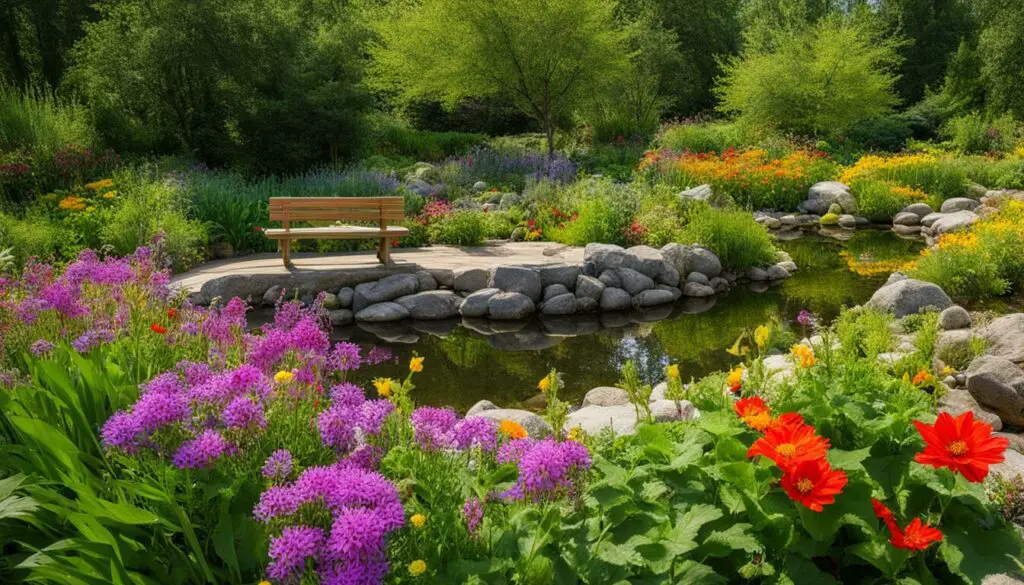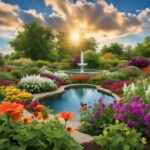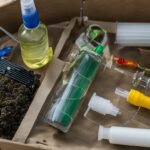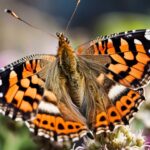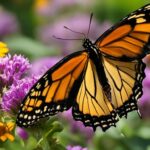Butterflies and other pollinators play a crucial role in maintaining the lifecycles of many plants that humans and animals depend on for food. By setting up a butterfly garden, you can help preserve their habitat and attract more butterflies to your yard. In this guide, I will provide you with simple steps to create a butterfly-friendly environment in your own backyard.
Key Takeaways:
- Setting up a butterfly habitat in your garden helps preserve their habitat and attract more butterflies.
- Choose a location with sufficient sunlight and consider the quality of the soil.
- Select native plants that attract butterflies and provide both host plants and nectar plants.
- Create a suitable environment with elements like sunning spots, shady areas, and water features.
- Maintain your butterfly garden by weeding, trimming, and avoiding the use of pesticides.
Picking the Perfect Location
When creating a butterfly garden, selecting the right location is crucial for the success of your habitat. Consider the amount of sunlight the area receives, as most native plants that attract butterflies require at least half a day of full sun. Sunlight is essential for the growth and blooming of these plants, providing nectar sources for adult butterflies.
Assess the quality of the soil in the chosen area. If the soil is acidic, rocky, or predominantly clay, it may not be ideal for butterfly-friendly plants. Consider adding compost or nutrient-rich topsoil to improve soil quality and provide a better environment for your plants to thrive.
Remember that the location of your butterfly garden should be easily accessible for you to maintain and enjoy. Choosing a spot near a seating area or a window can provide you with a delightful view of butterflies fluttering in your garden.
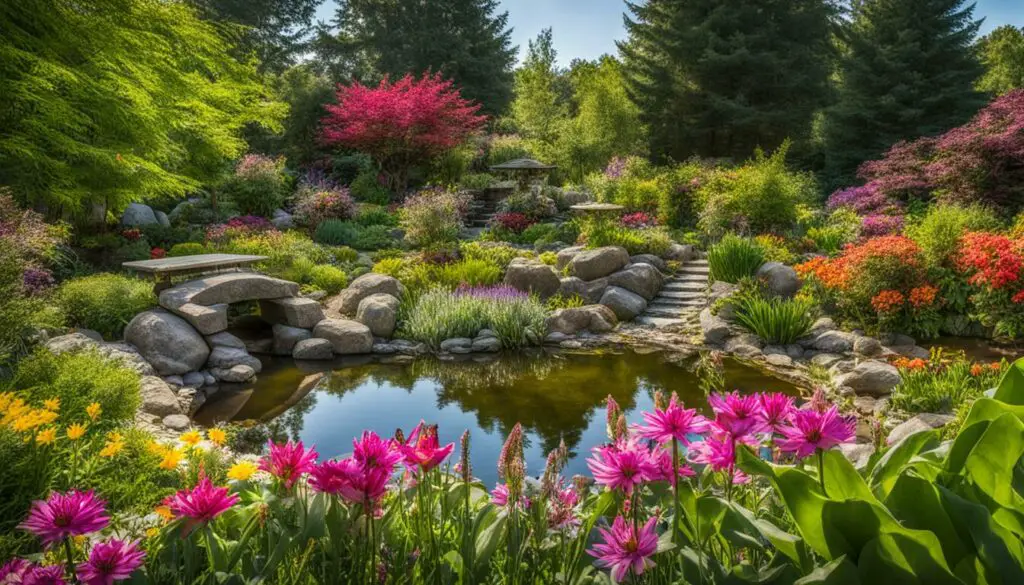
Table: Sunlight and Soil Requirements for Butterfly Gardens
| Native Plants | Minimum Sunlight Requirement | Ideal Soil Type |
|---|---|---|
| Milkweed | Full sun (at least 6 hours) | Well-drained soil |
| Echinacea | Full sun (at least 6 hours) | Well-drained soil |
| Black-eyed Susan | Full sun (at least 6 hours) | Well-drained soil |
By carefully considering the sunlight and soil conditions in your chosen location, you can create an optimal environment for butterflies to thrive and enjoy the beauty and wonder of these fascinating creatures.
Choosing the Right Plants
When it comes to creating a butterfly garden, choosing the right plants is crucial. Native plants are the best choice as they attract butterflies that are naturally found in your region. These plants are adapted to the local climate and will provide a familiar and suitable habitat for butterflies.
Incorporate a mix of both host plants and nectar plants in your garden. Host plants are essential as they provide a place for butterflies to lay their eggs and caterpillars to feed. Some common host plants include milkweed, parsley, and fennel. Nectar plants, on the other hand, provide a source of food for adult butterflies. They have flowers that produce nectar, which is a vital energy source for butterflies.
Research the native plants that attract butterflies in your area and choose a variety that blooms at different times throughout the year. This will ensure a continuous supply of food for the butterflies in your garden. A diverse range of colors and flower shapes will also attract a wide variety of butterfly species.
To make it easier for butterflies to find the plants, cluster them together in groups. This will create a more prominent visual display and make it easier for butterflies to locate the flowers. Remember to provide a mix of sunny and shady areas in your garden to cater to different butterfly species’ preferences.
| Native Plants for Butterfly Garden | Type | Bloom Time | Height |
|---|---|---|---|
| Milkweed | Host Plant | Summer | 2-5 feet |
| Black-Eyed Susan | Nectar Plant | Summer | 1-3 feet |
| Purple Coneflower | Nectar Plant | Summer | 2-5 feet |
| Aster | Nectar Plant | Fall | 1-6 feet |
| Butterfly Weed | Nectar Plant | Summer | 1-3 feet |
Host Plants
One crucial element of creating a butterfly-friendly environment is providing host plants. These are the plants where butterflies lay their eggs, and they serve as a food source for the emerging caterpillars. For example, monarch butterflies rely on milkweed as their host plant. Milkweed is the sole food source for monarch caterpillars, so it is essential to include it in your butterfly garden. Another great host plant is parsley, which attracts black swallowtails. By incorporating host plants into your garden, you can support the entire lifecycle of butterflies and increase the chances of their successful reproduction.
If you’re wondering which host plants are suitable for your region, it’s important to choose native plants. Native host plants are more likely to attract native butterflies, as they have evolved together and provide the necessary resources for each other’s survival. Research the native host plants in your area to create a more targeted and effective butterfly habitat.
“Native host plants are the cornerstone of a successful butterfly garden. By including them in your garden, you are not only providing a food source for caterpillars but also creating a natural habitat for native butterflies to thrive.” – Butterfly enthusiast
Table: Popular Host Plants for Butterflies
| Butterfly Species | Host Plant |
|---|---|
| Monarch | Milkweed |
| Black Swallowtail | Parsley |
| Gulf Fritillary | Passionflower |
| Painted Lady | Thistle |
| Eastern Tiger Swallowtail | Willow |
Adding host plants to your butterfly garden not only supports the butterfly population but also enhances the biodiversity and ecological balance in your backyard. The presence of diverse host plants attracts a variety of butterfly species, making your garden a vibrant and lively sanctuary for these beautiful creatures.
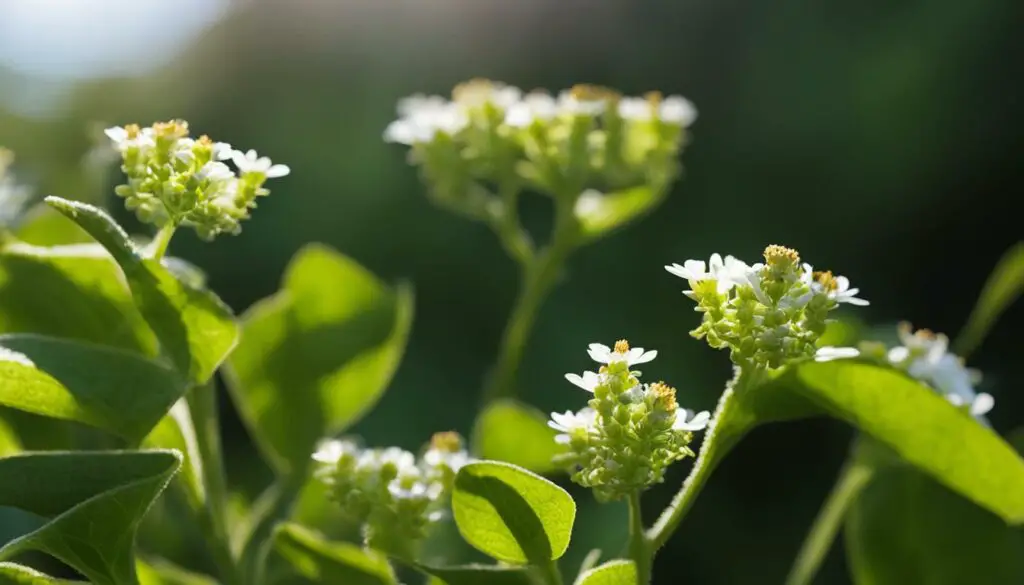
Nectar Plants
Creating a butterfly-friendly environment involves including a variety of nectar plants in your garden. These plants provide a valuable food source for adult butterflies, helping to sustain their populations. Native wildflowers such as Aster, Echinacea, and Black-eyed Susan are excellent choices for attracting butterflies with their vibrant blooms and rich nectar.
By planting a diverse selection of nectar plants that bloom throughout the spring and summer, you can ensure a continuous supply of food for butterflies. This will not only attract a wide range of butterfly species, but also provide them with the sustenance they need to thrive.
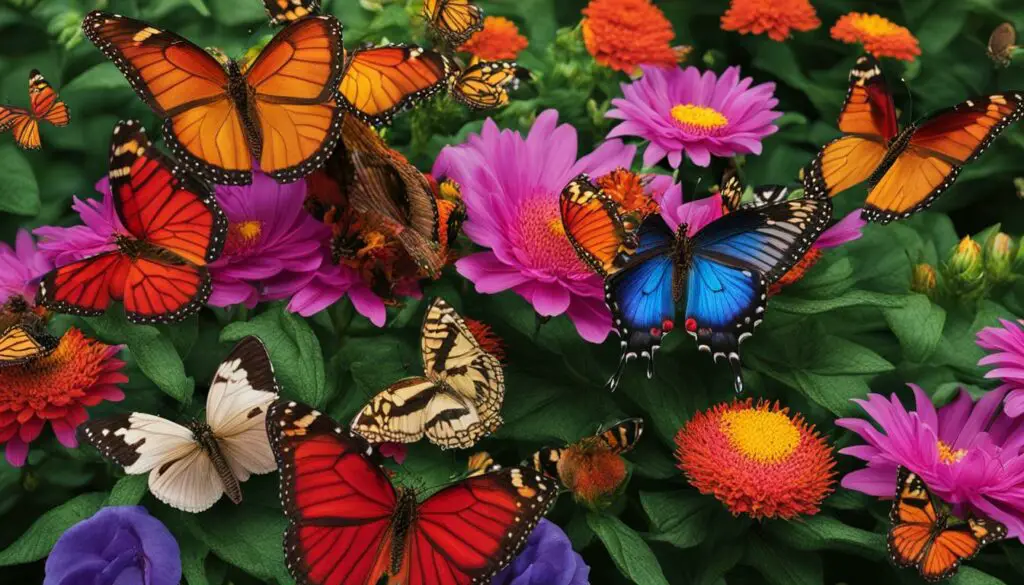
To maximize the effectiveness of these nectar plants, it’s important to cluster them together. This makes it easier for butterflies to locate the flowers and increases the chances of them utilizing them as a food source. Additionally, consider including flowers in shades of red, orange, yellow, and purple, as these colors tend to be particularly attractive to butterflies.
Benefits of Nectar Plants:
- Provide a vital food source for adult butterflies
- Attract a diverse range of butterfly species
- Ensure a continuous supply of nectar throughout the season
“Nectar plants are essential for providing food for adult butterflies and attracting a vibrant array of species.” – Butterfly enthusiast
By incorporating native wildflowers like Aster, Echinacea, and Black-eyed Susan into your butterfly garden, you can create a visually stunning and life-sustaining habitat for these beautiful creatures.
Plant Orientation
When creating your butterfly garden, it’s important to pay attention to the orientation of your plants. Clustering flowers of the same species and color can make it easier for butterflies to spot them and increase their chances of utilizing them. Butterflies are particularly attracted to flowers in shades of red, orange, yellow, and purple, so incorporating these colors into your garden can attract more butterflies.
To create a visually appealing and butterfly-friendly garden, consider planting flowers in groups or clusters of the same species. This not only makes it easier for butterflies to find the flowers but also creates a striking visual impact. By clustering flowers, you can ensure that butterflies have access to a concentrated food source, enhancing their overall experience in your garden.
Additionally, be mindful of the height and structure of your plants. Taller plants can serve as natural perches for butterflies, providing them with resting spots and vantage points to survey their surroundings. Mixing different heights and textures can create a diverse and attractive garden that appeals to a wide range of butterfly species.
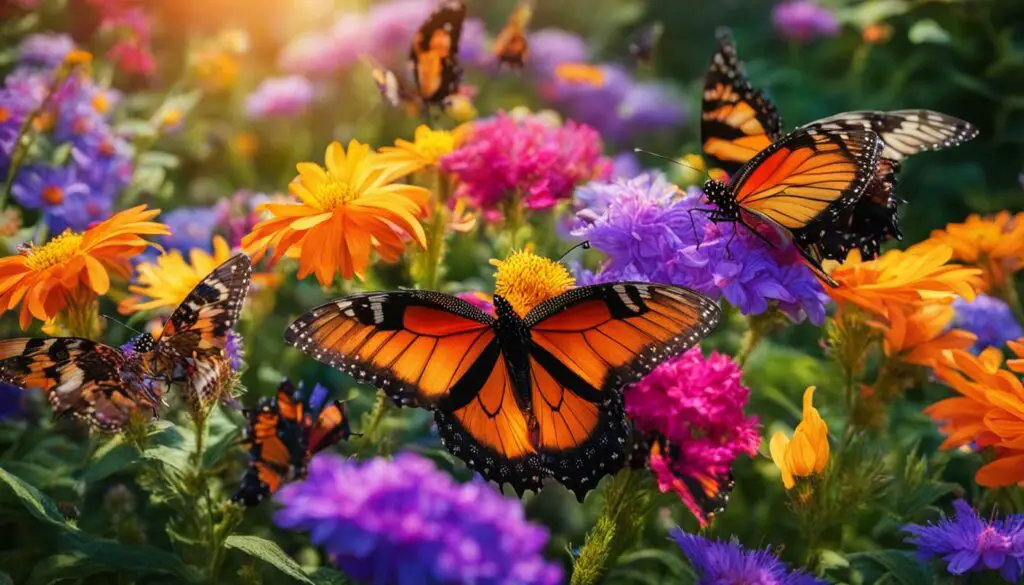
Creating a visually engaging and well-planned garden with clustered flowers and a variety of colors can greatly enhance the attractiveness of your butterfly habitat. Not only will it provide a welcoming environment for butterflies, but it will also add beauty and charm to your outdoor space.
Butterflies Need More Than Plants!
Creating a butterfly habitat goes beyond just planting the right flowers. To provide an optimal environment for butterflies, it’s crucial to consider their other needs as well. Here are some additional elements you can incorporate into your butterfly garden:
- Sunning spots: Butterflies are cold-blooded creatures that rely on the sun to warm their bodies. Flat rocks placed strategically in your garden can serve as ideal sunning spots for them to bask in the warmth.
- Shady spots: While butterflies love the sun, they also need areas of shade to rest and seek refuge from excessive heat or predators. Larger shrubs or trees can provide these much-needed shady spots in your garden.
- Windbreaks: Creating windbreaks not only protects your garden from strong winds but also provides a calm and tranquil space for butterflies to flutter about undisturbed. Erecting fences or planting wind-resistant shrubs can serve as effective windbreaks.
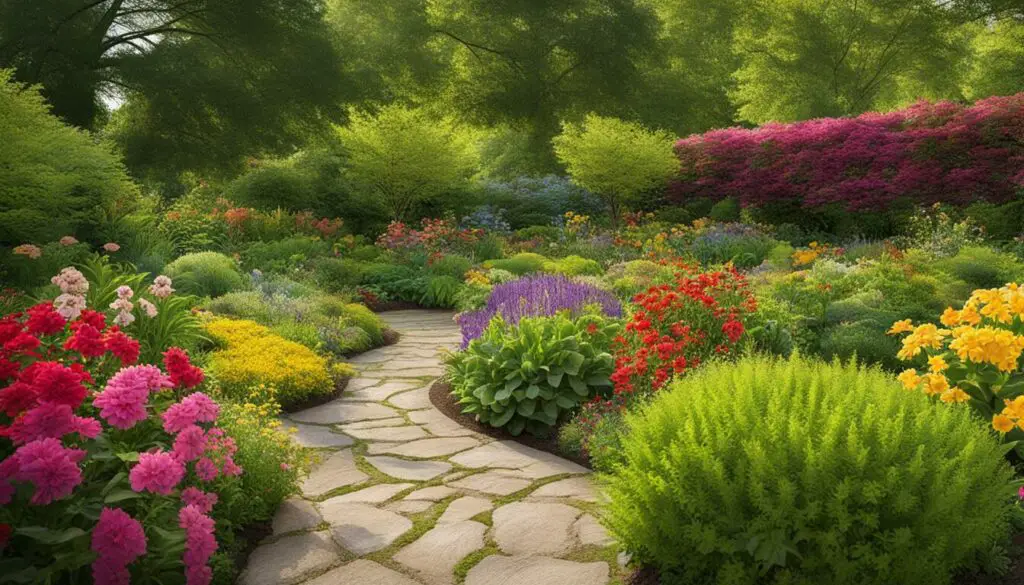
“By providing sunning spots, shady areas, and windbreaks, you can create a diverse and inviting habitat for butterflies.”
Water features: Including water features like birdbaths or shallow puddles in your butterfly garden can be a great way to attract and support these beautiful insects. Butterflies often visit these water sources to drink and obtain essential minerals, and they can also provide a resting place for caterpillars.
Remember to keep the water shallow and add a few pebbles or stones for butterflies to perch on while they drink. This will ensure their safety while enjoying the refreshing water.
By considering these additional elements in your butterfly garden design, you can create a diverse and inviting habitat that meets the various needs of butterflies at different stages of their lifecycle.
Maintenance
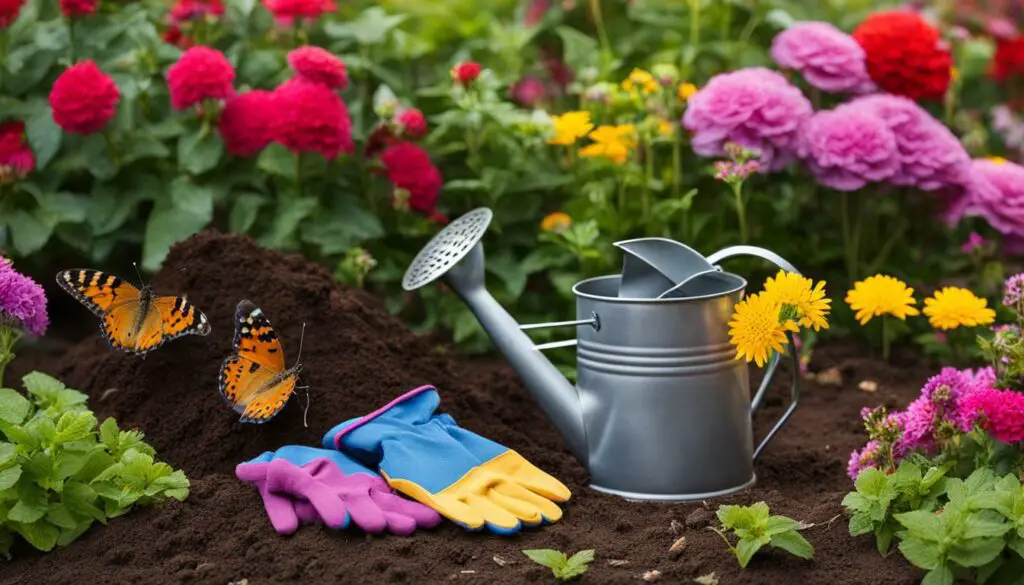
Once your butterfly garden is established, it will require regular maintenance to ensure its continued success. Here are some essential tasks to keep your butterfly habitat thriving:
- Weeding: Regularly weed your garden to prevent unwanted plants from competing with your butterfly-friendly plants.
- Trimming: Trim any overgrown plants to maintain their shape and prevent them from overshadowing other plants in your garden.
- Watering: Provide regular watering to ensure your plants receive adequate moisture. However, be careful not to overwater, as excessive moisture can lead to root rot and other issues.
- Avoiding pesticides: Avoid the use of pesticides or insecticides in your butterfly garden, as they can harm the very butterflies you are trying to attract. Instead, embrace the presence of lightly-chewed leaves, as they indicate an active and healthy butterfly garden.
By staying on top of these maintenance tasks, you can create a thriving habitat that will continue to attract and support butterflies for years to come.
Steps To Raise Monarch Butterflies
Raising monarch butterflies is a rewarding and educational experience that allows you to witness their fascinating life cycle up close. By providing the right conditions and care, you can successfully raise monarch caterpillars, witness the transformation into chrysalises, and eventually release the emerging monarch butterflies into the wild. Here are the key steps to follow:
Gather Monarch Eggs and Caterpillars
The first step in raising monarch butterflies is to find their eggs or caterpillars. Monarchs lay their eggs exclusively on milkweed plants, so it’s essential to have a supply of fresh milkweed leaves in your garden. Search for small, white eggs on the underside of milkweed leaves, or look for caterpillars that have already hatched. Carefully collect the eggs or caterpillars and transfer them to a suitable container.
Provide Adequate Housing and Food
Once you have collected the monarch eggs or caterpillars, it’s important to provide them with suitable housing and food. Place the eggs or caterpillars in a clean container with proper ventilation. For caterpillars, place fresh milkweed leaves in the container, ensuring they have enough food to feed on. Replace the leaves regularly to provide a continuous food source as the caterpillars grow.
Observe the Transformation into Chrysalises
As the caterpillars feed and grow, they will eventually form chrysalises. These chrysalises serve as protective casings during the transformation into adult butterflies. Observe the chrysalises closely, as you may witness the incredible moment when the adult butterfly emerges. It’s essential to avoid disturbing the chrysalises during this delicate phase and provide a calm and quiet environment.
By following these steps, you can raise monarch butterflies and contribute to their conservation. It’s important to release the adult butterflies into a suitable habitat once they emerge. By providing a safe environment for monarch butterflies, you are playing a crucial role in their survival and supporting the overall ecosystem.
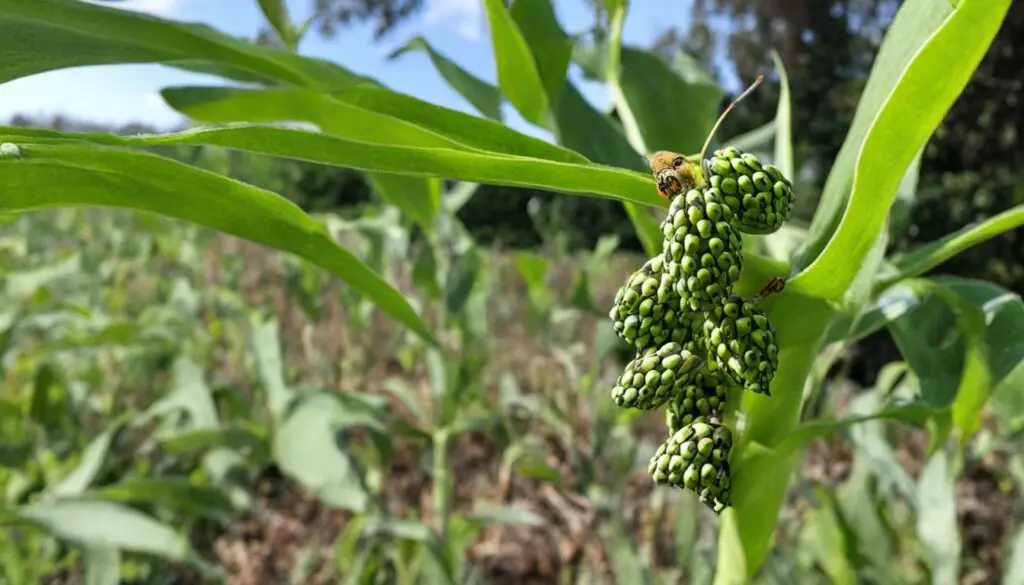
| Stage | Description |
|---|---|
| Egg | Monarch butterflies lay small, white eggs exclusively on milkweed plants. |
| Caterpillar | The caterpillar stage is characterized by rapid growth and feeding on milkweed leaves. |
| Chrysalis | The caterpillar forms a chrysalis, within which it undergoes metamorphosis. |
| Adult Butterfly | The adult butterfly emerges from the chrysalis and is ready to be released into the wild. |
Preparations for Getting Started
Before embarking on the journey of raising monarch butterflies, there are a few essential preparations you need to make. These preparations will ensure that you have everything you need to provide a safe and nurturing environment for the caterpillars and butterflies.
Preparing Containers for Caterpillars
When raising monarch butterflies, it’s important to have suitable containers for the eggs and caterpillars. Plastic containers with paper towels and water drops can create a suitable environment for their early stages of life. The containers should be spacious enough to accommodate the growing caterpillars and provide adequate ventilation.
Finding Milkweed for Monarchs
Milkweed is the primary food source for monarch caterpillars, so it’s crucial to have a ready supply of fresh leaves. You can find milkweed plants at local nurseries or online plant retailers. Make sure to choose a variety that is native to your region, as it will be more beneficial for the monarchs and other native butterflies.
Purchasing Butterfly Enclosures
Butterfly enclosures are useful tools for raising monarch butterflies. These enclosures provide a controlled environment where the caterpillars can safely transform into chrysalises and eventually emerge as adult butterflies. You can purchase butterfly enclosures online or at specialized butterfly garden supply stores.
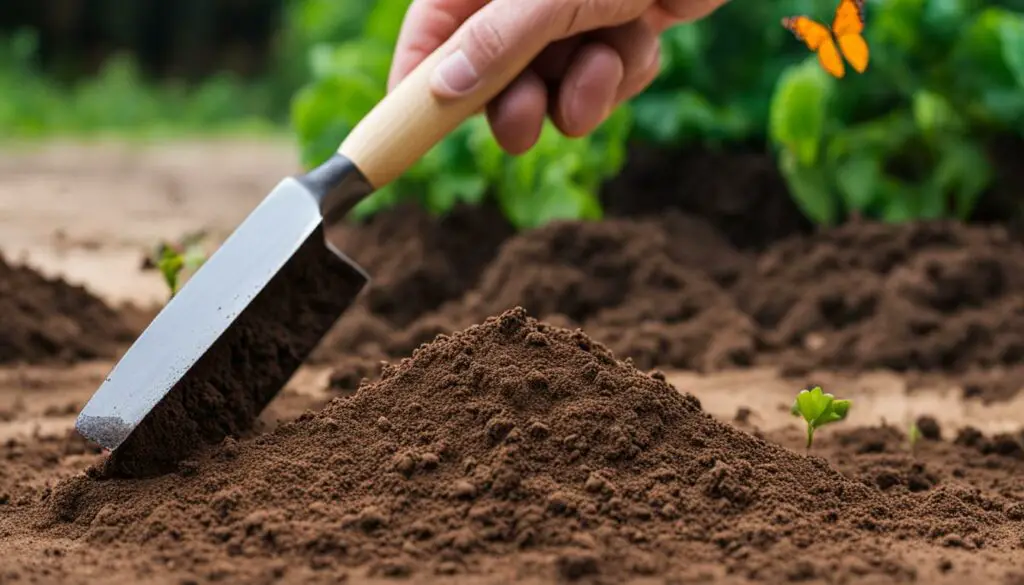
Table: Essential Preparations for Raising Monarch Butterflies
| Preparation | Description |
|---|---|
| Containers for Caterpillars | Prepare spacious plastic containers with paper towels and water drops for the eggs and growing caterpillars. |
| Finding Milkweed | Locate a reliable source of fresh milkweed leaves, which are the primary food for monarch caterpillars. |
| Purchasing Butterfly Enclosures | Invest in butterfly enclosures to provide a controlled environment for the caterpillar-to-butterfly transformation. |
By making these preparations, you will be well-equipped to begin raising monarch butterflies. Remember to handle the caterpillars and butterflies with care, providing them with ample food, and releasing the adult butterflies back into the wild once they have emerged from their chrysalises.
Get to Know Your Soil
Soil preparation is a crucial step in creating a successful butterfly garden. Understanding your soil type and its drainage capabilities is essential for the healthy growth of butterfly-friendly plants. Well-drained soil is particularly important as it helps prevent waterlogged roots and fungal diseases that can harm your plants.
One way to improve soil drainage is by adding compost. Compost helps loosen compacted soil and improves its structure, allowing for better water infiltration and nutrient absorption. It also provides essential organic matter that enriches the soil and supports the growth of beneficial microorganisms.
For those with challenging soil conditions, such as heavy clay or poor drainage, raised bed gardening can be an excellent solution. Raised beds allow you to control the quality of the soil, ensuring optimal conditions for your butterfly garden. They also provide better aeration and facilitate root development, leading to healthier plants.
Remember, the quality of your soil directly impacts the success of your butterfly garden. Take the time to assess your soil type, improve its drainage if necessary, and consider raised bed gardening for optimal soil conditions. Your efforts will be rewarded with a thriving and beautiful butterfly habitat.
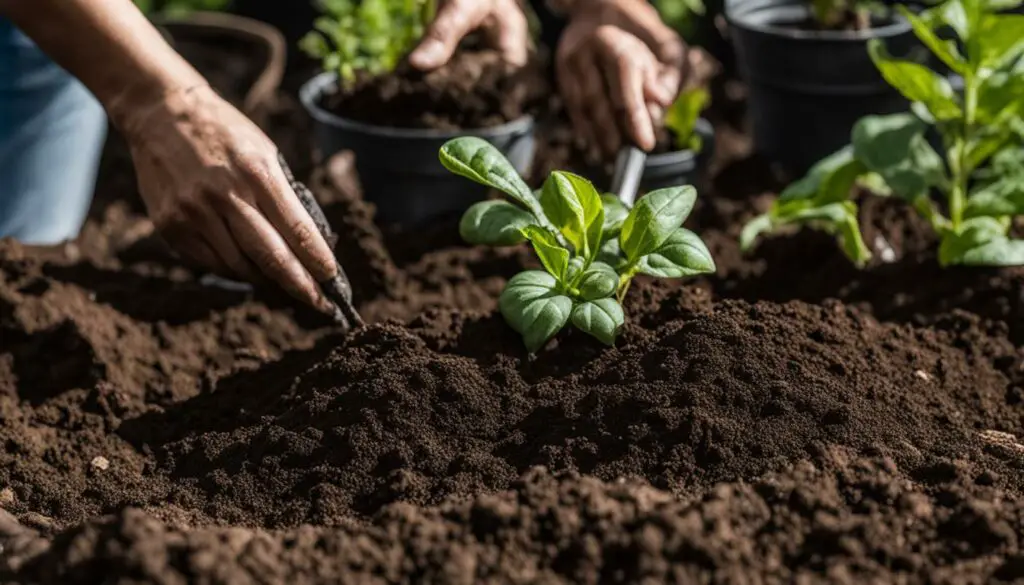
Table: Soil Types and Their Characteristics
| Soil Type | Characteristics |
|---|---|
| Clay Soil | Heavy and compacted, poor drainage |
| Sandy Soil | Light and loose, quick drainage |
| Loam Soil | Well-balanced, nutrient-rich, good drainage |
| Silt Soil | Smooth and fine, retains moisture but drains poorly |
| Chalky Soil | Alkaline, drains quickly, lacks nutrients |
Source: example.com
Plant Selection
Choosing the right plants for your butterfly garden is crucial to its success. Native plants are highly recommended as they are adapted to the local climate and attract native butterflies. Include a mix of nectar plants, which provide food for adult butterflies, and caterpillar food plants, which serve as host plants for butterfly larvae.
Native plants are specifically suited to the needs of local butterflies and are more likely to thrive in your garden. They also support local ecosystems and contribute to biodiversity conservation. Research native plants that are suitable for your region and that attract a variety of butterfly species. Online resources, such as plant lists and gardening books, can provide valuable information on suitable native plants for butterfly habitats.
When selecting plants, consider the different preferences of butterflies. Nectar plants attract adult butterflies with their vibrant flowers and sweet nectar. Examples include milkweed, coneflowers, and black-eyed Susans. Caterpillar food plants, on the other hand, provide a food source for butterfly larvae. Monarch butterflies, for instance, rely on milkweed as their sole food source. Research the specific caterpillar food plants required by the butterfly species you wish to attract.
Native Plants for Butterfly Habitat
Below is a table showcasing some commonly recommended native plants for butterfly gardens:
| Plant Name | Type | Butterfly Species attracted |
|---|---|---|
| Milkweed | Caterpillar food plant | Monarch butterflies |
| Butterfly Bush | Nectar plant | Various butterfly species |
| Purple Coneflower | Nectar plant | Various butterfly species |
| Joe-Pye Weed | Nectar plant | Various butterfly species |
Remember, the key is to provide a diverse range of plants that bloom at different times throughout the year. This ensures a constant supply of food and attracts a wider variety of butterfly species to your garden. By selecting the right plants, you can create a beautiful and thriving butterfly habitat that benefits both butterflies and the overall ecosystem.
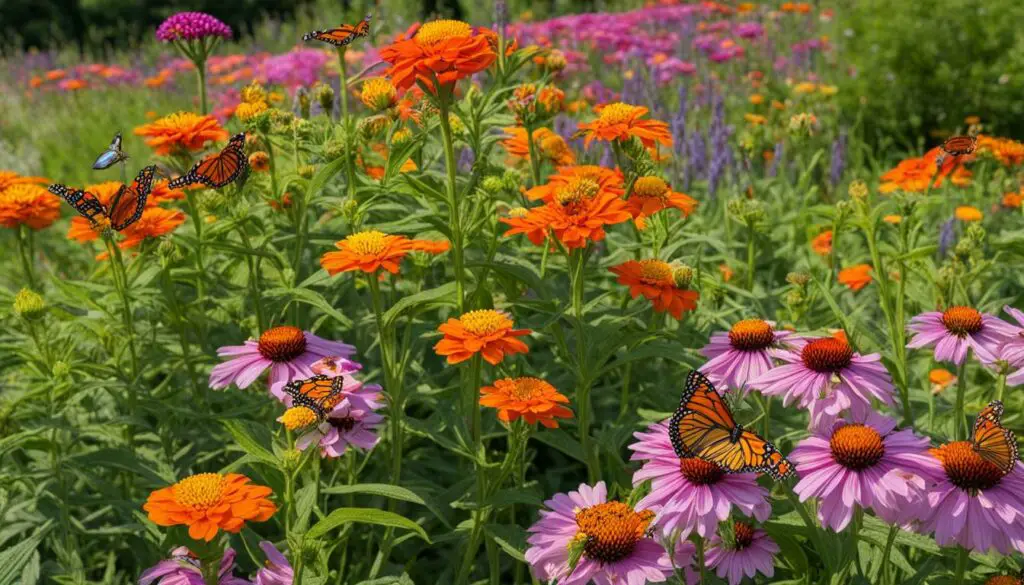
Monarchs
Monarch butterflies have been experiencing a significant decline in population, making their conservation efforts more crucial than ever. One of the key factors affecting monarch populations is the loss of their natural habitat. Not only do these beautiful creatures rely on specific plants for food and shelter, but they also require milkweed to complete their lifecycle.
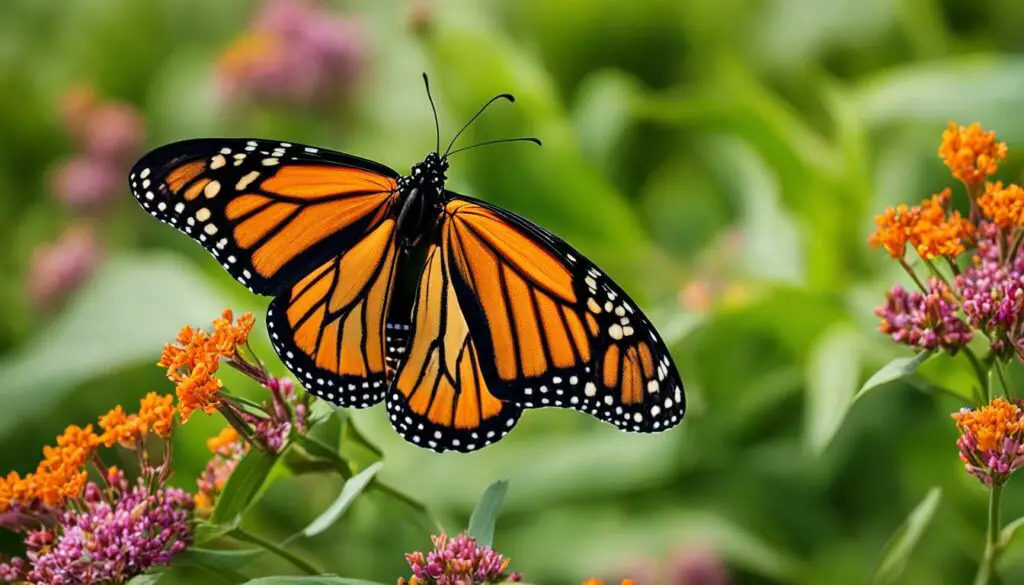
Planting milkweed in your butterfly garden is a simple yet impactful way to support monarch conservation. As the sole food source for monarch caterpillars, milkweed plays a vital role in their survival and reproduction. By including milkweed in your garden, you provide a safe and nourishing environment for monarchs to thrive.
There are several species of milkweed to choose from, such as common milkweed (Asclepias syriaca) and swamp milkweed (Asclepias incarnata). Consider planting a variety of milkweed species to ensure a continuous supply of food for monarch caterpillars throughout their active seasons. By providing milkweed in your garden, you are directly contributing to the preservation of these remarkable butterflies.
Conclusion
Setting up butterfly habitats in your garden is a wonderful way to create a butterfly-friendly environment and contribute to their preservation. By following the simple steps outlined in this guide, you can establish a welcoming space for these beautiful creatures to thrive.
A well-designed butterfly garden not only attracts butterflies but also helps sustain their populations and supports pollination of plants. It’s a rewarding experience to watch these magnificent insects fluttering around your yard and knowing that you are playing a part in their conservation.
Remember to choose native plants that are suitable for your region and include both host plants for butterfly larvae and nectar plants for adult butterflies. Properly maintain your garden by weeding, trimming, and avoiding the use of pesticides. This will create a healthy habitat that butterflies can rely on for food and shelter.
So, let’s get started on creating a butterfly-friendly environment! Whether you have a small patio or a spacious yard, setting up a butterfly habitat is a simple and impactful way to make a positive difference for these delicate creatures and enhance the beauty of your outdoor space.
FAQ
Why is setting up a butterfly garden important?
Butterflies and other pollinators play a crucial role in maintaining plant lifecycles that we and animals rely on for food. Creating a butterfly garden helps preserve their habitat and attracts more butterflies to your yard.
What factors should I consider when choosing a location for my butterfly garden?
Consider the amount of sunlight the area receives, as most native plants that attract butterflies require at least half a day of full sun. Also, assess the quality of the soil and make improvements if necessary.
What types of plants should I include in my butterfly garden?
It is important to use native plants that grow naturally in your region as they are more likely to attract native butterflies. Research native plants that attract butterflies and include both host plants and nectar plants in your garden.
What are host plants and why are they important?
Host plants are where butterflies lay their eggs, and they are essential for the butterfly lifecycle. Examples of host plants include milkweed for monarch butterflies and parsley for black swallowtails. Make sure to choose host plants native to your region to attract native butterflies.
What are nectar plants and why are they important?
Nectar plants provide food for adult butterflies. Include native wildflowers like Aster, Echinacea, and Black-eyed Susan in your garden to attract butterflies. Ensure there is a continuous supply of blooming flowers throughout the spring and summer.
How should I arrange my plants in the butterfly garden?
Cluster plants by species and color to make it easier for butterflies to spot the flowers. Butterflies are primarily attracted to red, orange, yellow, and purple flowers.
Apart from plants, what other elements should be included in a butterfly garden?
Provide flat rocks for sunning spots, create shady areas and larger shrubs for shelter from the wind, and consider adding water features like birdbaths for butterflies to “puddle” and obtain hydration and minerals.
How much maintenance does a butterfly garden require?
Native plants in butterfly gardens require minimal maintenance. You may need to weed, trim, and water as necessary. Avoid using pesticides or insecticides, as they can harm the butterflies you are trying to attract.
How can I raise monarch butterflies?
To raise monarch butterflies, you need to find their eggs on milkweed plants and provide proper care for the caterpillars and chrysalises. Once they emerge as adult butterflies, they can be released into the wild.
What preparations do I need to make for raising monarch butterflies?
Prepare containers with paper towels, water drops, and fresh milkweed leaves for the early stages of monarch butterfly life. Consider purchasing butterfly enclosures for raising monarch butterflies.
What should I know about my soil before planting a butterfly garden?
Most butterfly plants thrive in well-drained soil that is rich in organic matter. Adding compost can improve soil structure and provide necessary nutrients. Raised bed gardening is also an option for better soil control.
How do I choose the right plants for my butterfly garden?
Select plants native to your region that attract butterflies. Include both nectar plants for adult butterflies and caterpillar food plants for their lifecycle. Use resources like plant lists and gardening books to assist in plant selection.
Why is planting milkweed important for monarch butterflies?
Milkweed is crucial for the survival of monarch butterflies, as it is the only plant they lay their eggs on and that their caterpillars feed on. Planting milkweed in your butterfly garden can help support monarch conservation efforts.

